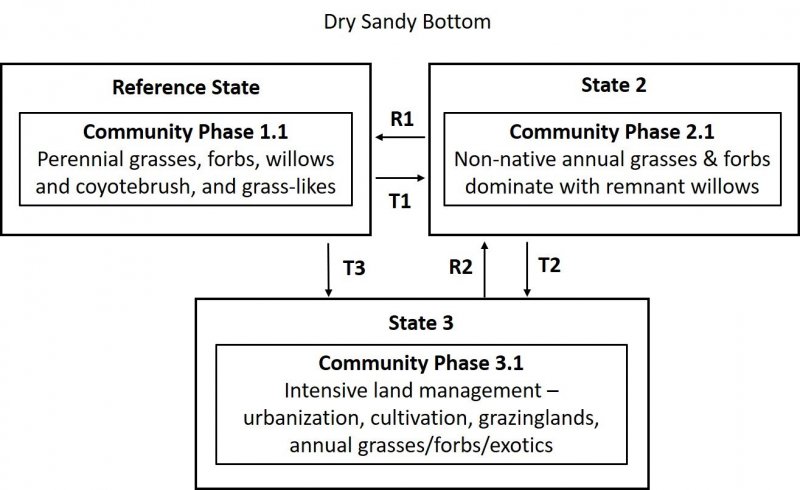Ecological site group R014XG908CA
Dry Sandy Bottom
Last updated: 09/07/2023
Accessed: 12/21/2025
Ecological site group description
Key Characteristics
None specified
Provisional. A provisional ecological site description has undergone quality control and quality assurance review. It contains a working state and transition model and enough information to identify the ecological site.
Physiography
This ESG is found typically on flood plains and alluvial fans and have slopes of 0 to 15 percent.
Climate
The average annual precipitation in this area is 11 to 53 inches (272 to 1,353 millimeters). This ESG is found in the drier portions of the MLRA, averaging 11-18 inches. The higher amounts of precipitation occur at the higher elevations in the area north of San Francisco. Most of the rainfall occurs as low- or moderate-intensity, Pacific frontal storms during winter. This area is very dry from midspring to midautumn. Snowfall is rare. The average annual temperature is 54 to 61 degrees F (12 to 16 degrees C). The freeze-free period averages 315 days and ranges from 265 to 365 days. It is longest near the coast, and it becomes shorter with elevation.
Soil features
This ESG is found on sandy soils that are very deep and somewhat excessively drained that formed in alluvium from granitic sources.
Metz, a sandy, mixed, thermic Typic Xerofluvent
Tujunga, a mixed, thermic Typic Xeropsamment
Vegetation dynamics
This ESG covers the areas of the valleys in MLRA 14 that were at one time part of a vast complex of marshes, tidal flats, estuaries, wetlands, riparian areas, and wet meadows. The urbanized landscape in the valleys within this MLRA that exists today makes it difficult to imagine the natural landscape prior to human development.
These dry sandy bottoms were likely the sandy-textured fluventic soils related to fresh sandy deposits of moving waters in the network of mainly freshwater, and some salt marshes, rivers and streams that ran through these valleys as their seasonal and tidally influenced flood waters stretched across the flood plains and terraces in spring and deposited sediment as they receded during summer. Once the area began to be settled by humans, many of these water dominated ecosystems were drained, leveed, cleared for crops and other agriculture, and urbanized.
As this landscape was de-watered and houses and agriculture took over, the water table for many of these habitats moved deeper and deeper, creating soils that would no longer offer the available soil moisture for many of the plants that had evolved with the hydrologic function of the natural system that no longer existed. These dry sandy fans and flood plains may have remained wetter than many of the surrounding soils, due to their relation to run on and river/stream waters, increasing seasonal available water capacity. These sandier textures will dry out more rapidly through both drainage and evapotranspiration in the summer months making them less hospitable for many of the native perennial grasses and more dominated by annual grasses and forbs. Annual production will still be higher than the ESGs in uplands, due to the available waters to these soils each growing season.
Historically, this site may have looked similar to a combination of the CWHR wet meadow and riparian classifications, however with the introduction of non-native annual grasses and the impacts from cultivation, grazing, fragmentation, continued de-watering, and human alterations such as homes and roads, this site now reflects a lower producing, dry, annual grassland where it is not converted.
Currently, where this site is not under cultivation or urban developments, it is dominated by non-native annual grasses. These include wild oats, soft chess, ripgut brome, red brome, wild barley, and foxtail fescue. Common forbs include broadleaf filaree, redstem filaree, turkey mullein, true clovers, bur clover, popcorn flower, and many others. Perennial grasses, found in moist, lightly grazed, or relic grassland areas, may include creeping wildrye and blue wildrye and areas of intermittent ponding will have sedges and occasional willows and/or coyotebrush. Species composition is also related to water availability with greater amounts of relic perennial grasses and forbs in areas of greater precipitation or soil moisture.
Information from:
John G. Kie
California Wildlife Habitat Relationships System
California Department of Fish and Game
California Interagency Wildlife Task Group
Major Land Resource Area
MLRA 014X
Central California Coastal Valleys
Stage
Provisional
Click on box and path labels to scroll to the respective text.


